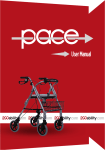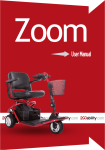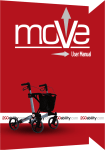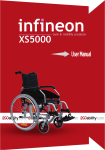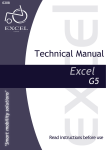Download User Manual - Scoota Mart
Transcript
ACCESS User Manual YOU AND / OR YOUR ATTENDANT MUST READ AND FULLY UNDERSTAND THIS MANUAL BEFORE USE General information You have just purchased a 2GOability wheelchair and we want to thank you for the confidence in our 2GOability products. The wheelchair is a quality product. The policy of 2GOability is to continually improve the quality and reliability of our products. We reserve the right, therefore without prior notification, to alter this guide. It is important that your guide for the use of the wheelchair is read carefully. The manual contains important information about the safe use and maintenance of your wheelchair. We recommend that you keep this guide, it is also your proof of warranty and you will find it useful for referring to it at a later date. The safety instructions in this guide are general guidelines that must be seen as broad guidelines. It is possible that you develop your own ways for many common actions. However, we advise you to consult a professional for assistance in developing safe and effective techniques with regards to your daily activities and your physical capabilities. Your new wheelchair requires frequent maintenance, much of which you can do yourself. Caution! In this guide you will find informative information and warnings. These are clearly identified by the symbols below and the appearance of the text: Tip Informative information Warning To avoid personal injury, warnings must be followed 1 Fill out the information on your authorized dealer below: Company: ………………………………………………………………… Address: ………………………………………………………………… ………………………………………………………………… Telephone number: ………………………………………………………………… Fax number: ………………………………………………………………… Email address: ………………………………………………………………… Website: ………………………………………………………………… 2 1 IDENTIFICATION ............................................................................................................ 4 2 GENERAL EXPLANATION CONCERNING YOUR WHEELCHAIR .......................................... 5 2.1 Components of the wheelchair ..........................................................................................5 2.2 General explanation of the function and possibilities of your wheelchair .........................5 3 SAFETY REGULATIONS ................................................................................................... 6 3.1 General safety regulations .................................................................................................6 3.2 Warnings for safe use .........................................................................................................6 4 INSTRUCTIONS FOR USE ................................................................................................ 7 4.1 Safety tips ...........................................................................................................................7 4.2 Negotiating pavements and unequal surfaces ...................................................................8 4.3 Going up and down ramps .................................................................................................9 4.4 Going up and down stairs ...................................................................................................9 5 INSTRUCTIONS FOR USE AND MOUNTING OPTIONS ................................................... 11 5.1 Tools and technical information .......................................................................................11 5.2 Unfolding and folding the wheelchair ..............................................................................11 5.3 Use of the footplate and footrest.....................................................................................12 5.4 Using the drum brakes .....................................................................................................14 5.5 Using the foldable backrest ..............................................................................................14 5.6 Tire table ..........................................................................................................................15 5.7 Using the seat belt on your wheelchair ............................................................................15 6 TRANSPORT AND TRANSIT IN CAR............................................................................... 15 6.1 De-assembly .....................................................................................................................15 6.2 Assembly ..........................................................................................................................16 7 MAINTAINANCE .......................................................................................................... 16 7.1 Tyres .................................................................................................................................16 7.2 Brakes ...............................................................................................................................16 7.3 Cross brace .......................................................................................................................16 7.4 Rear wheel .......................................................................................................................17 7.5 Front castor and front castor fork ....................................................................................17 7.6 Upholstery ........................................................................................................................17 7.7 Cleaning ............................................................................................................................17 8 PROBLEM ANALYSIS AND SOLUTIONS ......................................................................... 18 9 WARRANTY ................................................................................................................. 19 9.1 Warranty application........................................................................................................19 9.2 Warranty definition ..........................................................................................................19 10 GENERAL MAINTENANCE INSTRUCTIONS ................................................................ 20 3 1 IDENTIFICATION Your wheelchair is equipped with a unique identification number. You can find this number on the cross frame of your wheelchair. Below is an example of the frame label on which you can find the identification number. Furthermore you will find the explanation of the various data stored on the frame label listed below. 2 5 1 6 6 3 4 7 7 1. Production date Production date of the wheelchair 2. Serial number The unique identification number. You must have this number when making technical requests or if warranty parts are required. 3. Maximum user weight The largest occupant weight allowed for protection of both the wheelchair and the user. 4. Type number This number indicates which model of wheelchair you have, again this is always required when making technical calls. 5. Model name The model name of your wheelchair. 6. Usage application Where you can use your wheelchair. 7. Warranty This is warranty period. Chapter 9 describes your warranty terms and conditions in more detail. 4 2 GENERAL EXPLANATION CONCERNING YOUR WHEELCHAIR 2.1 Components of the wheelchair 1 2 17 3 12 11 4 10 5 9 8 6 1 2 3 4 5 6 Backrest and coating Push handle Drum brake Frame Rear wheel Front wheel (swing castor) 7 7 8 9 10 11 12 Front fork Ball head Foot plate Foot rest Seat Armrest Your wheelchair is equipped with a number of elements and parts. You should know these before continue reading this manual. Designs and specifications may change without prior notice. 2.2 General explanation of the function and possibilities of your wheelchair Your wheelchair is a foldable one, which is designed to be easy to transport in a car. This is a transit wheelchair, the wheelchair has 12½” or 8” rear wheels, therefor you will need an attendant to push the wheelchair. Your wheelchair is a medical equipment product and is not a standard consumer product. You must follow this manual completely to ensure good, optimal and safe use of your wheelchair. 5 3 SAFETY REGULATIONS 2GOability specifically disclaims responsibility for any body injury or property damage which may occur during any use which does not comply with laws or ordinances. If used correctly, the 2GOability wheelchair is an utmost safe and stable product, if the instructions for use as described in this manual are followed. However, it is possible when the 2GOability wheelchair is not used correctly, dangerous situations may occur. 3.1 General safety regulations Protect your 2GOability wheelchair by checking it regularly. When a part of your wheelchair is not functioning properly, a dangerous situating could occur. Warning: You must keep your wheelchair in a good state to be able guarantee use and ambulatory the security in. 3.2 Warnings for safe use Warnings: Avoid using your wheelchair on roads. Use pavements if possible; Do not use your wheelchair in sand, rough area, wet and slippery surfaces or surfaces with little grip; This model of wheelchair is not suitable for use as a seat in a motor vehicle. The wheelchair could fail in a vehicle impact, leading to injury of the wheelchair occupant or others; Do not lean over the back of the wheelchair. This can result in rolling over the wheelchair; Do not drive into curbs; Before leaning or reaching forward, push bottom to back of the chair and face castors forwards; Never connect anything to the wheels, this may cause damage to the chair and also effect the balance of the chair and may injure the user; For suitable protection from potential obstruction the footrests should be a minimum of 7 cm clear of the ground; 6 Figure 1 4 Do not stand on the footrest this will cause the chair to tip and injure the user (figure 1); Place the wheelchair on a stable, flat surface and engage the brakes before transferring to or from the wheelchair; Engage the brakes when the user of the wheelchair is in or on a lift and when the user wants to get off; The maximum weight capacity has been indicated on your wheelchair frame label; Unauthorized modification and or use of parts not supplied by 2GOability will invalidate the warranty of this chair and may lead to injury to the user and or damage to the chair. INSTRUCTIONS FOR USE You will have to learn the characteristics of your wheelchair. It is most important to learn the safest methods to develop the daily activities in accordance to your life style. Consult your medical advisor or therapist for assistance by developing safe and effective techniques for your daily activities and your physical possibilities. 4.1 Safety tips Daily operations such as getting off the wheelchair, reaching and bending in the wheelchair will cause a change of weight distribution and in the center of gravity of you and your wheelchair. You will need to perform these movements and techniques as described below. Transferring Transferring in a wheelchair is a difficult manoeuvre. Consult your physical therapist for assistance in developing your individual technique. The possibilities you have for making a transfer are depending on your physical characteristics. We advise you to discuss this first with your physical therapist. However if you have sufficient body strength and you want to transfer to and from the wheelchair can you best do this in the following manner: 7 To get out of the wheelchair: First of all you must make sure that your wheelchair stands as closely as possible to the place of where you wish to transfer to. Put the castors forward and engage the brakes. Swing away the footplates and place your feet on the ground. You are now in position to carry out the operation. Shift your weight to the front of the chair, you can use the armrests as a support and move yourself to the place where you wish to transfer to. If necessary you can use a transfer board. To get in: To get in your wheelchair you need to do the same things as when you want to get out of the wheelchair, only in reversed order. Reaching: We strongly recommend that you seek the help of an attendant to pick something up for you. 4.2 Negotiating pavements and unequal surfaces Going up the pavement: The attendant can help you in two different ways, however we advise you to do it the first way. 1. In the first method for going up a pavement you and the attendant reach to pavement facing forward. The attendant must pull the push handles towards him and place his foot on the stepper on the rear side of the wheelchair, see figure 2. Because of this there is a leverage effect that tips the wheelchair. Figure 2 2. In the second method the attendant is already standing on the pavement and makes sure that the wheelchair is positioned with the rear wheels as close to the pavement as possible. The user of the wheelchair needs to lean backwards. This way the wheelchair will tip backwards and the attendant can pull the chair on the pavement. The attendant needs to make sure that the front wheels are on the pavement before he lets the wheelchair down. 8 Warning: Do not drive into curbs! Going down the pavement: The attendant should move the wheelchair forward to the curb. Then the user should lean back so the attendant can tilt the wheelchair to find a balance point. When the wheelchair is balanced the attendant can move the wheelchair slowly off the curb. When the wheelchair is off the pavement, the attendant can let the front wheels back onto the ground. 4.3 Going up and down ramps Inspect the slope always for risks, such as holes or slippery and uneven surfaces before you drive off. Warning: Do not carry any weight on the back of the wheelchair whilst ascending. This changes the balance and increases the chances of tipping backwards. You may recall earlier in the manual that you were instructed to ensure the footrests are a minimum 7 cm from the ground. One reason for this is that when you are descending a slope you need a minimum of this amount of clearance in order to ensure the footplates do not catch the end of the slope. 4.4 Going up and down stairs Stairs are one of the largest obstacles for wheelchair users. However, with a little help from others it is possible to climb up and down the stairs. Assessment of the weight that has to be moved should be undertaken by the attendants prior to this manoeuvre. Going upstairs You need to go upstairs backwards with two attendants, one attendant at the front and one attendant at the back. The attendant at the back grabs the push handles and let the wheelchair tip backwards until it is in balance. When the wheels are in balance the attendant at the front needs to grab the side frames. You are now in position to climb the stairs. The attendant on the front pushes the side frames up until they are above the first step and the attendant at the back makes the first step on the stairs. Repeat this technique until the last step of the stair. You can let the front castors down when the attendant at the front has taken the last step. 9 Going downstairs To go downstairs, the wheelchair should be facing forwards. The rear attendant should tip the wheelchair until it balances. The front attendant should support the wheelchair by holding the side frames. The wheelchair should then be slowly guided down each step. Warning: Never lift a wheelchair by the push handles, armrests or footrests. Always hold a part of the main frame. 10 MAKING ADJUSTMENTS TO YOUR WHEELCHAIR CAN CAUSE BIG RISKS FOR YOUR SAFETY AND THE FUNCTION OF YOUR WHEELCHAIR. ADJUSTMENTS MADE BY YOURSELF ARE STRONGLY ADVISED AGAINST AND CARRIED OUT AT YOUR OWN RISK. 5 INSTRUCTIONS FOR USE AND MOUNTING OPTIONS In this chapter we will explore all the possibilities that you have with your wheelchair. All setting and user instructions, such as the removal of the footrest, will be discussed. Your wheelchair is a 2GOability Access 5.1 Tools and technical information For the maintenance of your wheelchair you will, in some cases, need tools. For your wheelchair you will need the following tools: Phillips screwdriver Allen keys Cross-ring or keys Spanners Socket wrench PH2 4, 5 and 6 mm 8, 10, 13 and 26 mm 19 and 22 mm 19 mm 2GOability Access Seat width Seat depth Seat height Backrest height Total width Total length Total height Maximum user weight 45 cm 43 cm 50 cm 41 cm Seat width + 12 cm > 90 cm > 92 cm 100 kg 5.2 Unfolding and folding the wheelchair Unfolding the wheelchair Make sure you stand next to the wheelchair; Grab both seat tubes and move them apart; Push both seat tubes downwards so that the wheelchair will unfold, see picture 1; Go to the front of the wheelchair and push again on the seat tubes to ensure that they are directly on the frame. This is confirmed when the seat upholstery is flat; Place the footrests back, fold down the footplate, see chapter 5.3; You can now use the wheelchair. 11 Folding the wheelchair Fold away the footplates and remove the footrests, see chapter 5.3; Make sure you stand next to the wheelchair; Grab both grips on the side of the seating and pull them upwards, see picture 2. Picture 1 Picture 2 5.3 Use of the footplate and footrest Folding the footplate away Go to the front of the wheelchair and get a hold of the front of the foot plate, see picture 3; Fold the footplate in the direction of the footrest, see picture 4. Make sure the heel strap does not get stuck between the footplate and footrest, see picture 4. Picture 3 Picture 4 12 Removing the footrest from the wheelchair Go to the front of the wheelchair; Pull the black steel control lever to the inside of the wheelchair, see picture 5. You can now swing the footrest inwards or outwards; Swing the footrests 90˚ to the outside of your wheelchair and pull the complete footrest straight up from the tube. Placing the footrest back on your wheelchair Go to the front of the wheelchair; Place the footrest with an angle of 90° back on the chair, see picture 6; Swing the footrest to the front until you hear a click. This click confirmed that the footrest is in position; Check if everything is in position. Picture 5 Picture 6 Setting height of the footplate To adjust the height of the footplate you need to use enclosed wrench number 13. Remove the footplate from the wheelchair; Turn the footrest upside down. You will see the bottom of the footplate now; Loosen the bolt with wrench number 13 until you can move the footplate up and down; Select the desired height and tighten the bolt down; Make sure the footplate is in place and that the length is equal on both sides. 13 5.4 Using the drum brakes The drum brakes can be found on the push handles of the wheelchair. Squeeze the lever towards the black push handle to brake, see picture 7. You can also put a parking brake on. Squeeze the lever towards the black push handle; Keep the lever there and push the steel mechanic, with “lock‟‟ on it, on the black lever forward to brake, see picture 8; Squeeze again to remove the parking brake. Picture 7 Picture 8 5.5 Using the foldable backrest Go to the back of the wheelchair; Push at the same time both levers on the back of the wheelchair, see picture 9, to fold the backrest down, see picture 10; Picture 9 Picture 10 14 5.6 Tire table Wheelchair model Rear wheel Tire size front Tire size rear 2GOability „Access‟ 2GOability „Access‟ Transit 8" X 1 1/4" 8" x 1 1/4" Transit 8" X 1 1/4" 12½" x 2 1/4" 5.7 Using the seat belt on your wheelchair Your wheelchair is equipped with a seat belt which you can use the following way: When in the wheelchair, you can fasten the belt by clicking the two loose ends together, see picture 11; If the belt is to loose or to tight you can make it more secure or looser, see picture 12; To release the seat belt, you press on the lock plates to unlock. Picture 11 6 Picture 12 TRANSPORT AND TRANSIT IN CAR Your 2GOability wheelchair is designed to be easily transported by car. Your wheelchair is foldable so the total width is limited to an average measure of 20 cm. Further your wheelchair is equipped with swing away and detachable footrests and a foldable backrest. 6.1 De-assembly 1. 2. Take away the footrests on the front side of your wheelchair (see chapter 5 „Instructions for use and mounting options‟). Fold the wheelchair: Stand next to the wheelchair. Get a hold of the seat grips at the side and pull it straight up. 15 6.2 Assembly 1. 2. 7 Unfold the wheelchair: Go stand next to the wheelchair, tilt the wheelchair a bit towards you and push the seat tube down. The wheelchair will un-fold. Go stand before the wheelchair and push again on the two seat tubes to ensure that they are directly on the frame. This is confirmed by flat seat upholstery; Place the footrests back on the wheelchair. MAINTAINANCE There are a lot of things you can do yourself to keep your wheelchair in optimum condition. If you regularly check the wheelchair and perform (small) maintenance, this will extend the lifetime and increase the ease of use. 7.1 Tyres Examine tyres periodically for wear and replace them as needed. PU tyres: The tyres have the advantage that they do not need to be pumped up and can not be punctured. This PU tyre can wear out. Check periodically to see if the tread is still deep enough. 7.2 Brakes Inspect both brakes for sharp rims. If there are sharp rims on the brakes we advise you to replace them. Ensure that all the parts of the brake are in the right position and fastened secure; Make sure that the mechanism is functioning smoothly. If it is not functioning smoothly put some oil at turning points with one or two drips of WD40 oil or Teflon. Remove surplus oil and dirt; Make sure the brakes do not come into contact with the wheels as you are moving. 7.3 Cross brace The cross-frame of the wheelchair has to be in a good condition. The cross brace is the basic of your wheelchair. Make sure the wheelchair can easily be fold and unfold; Make sure the wheelchair travels in a straight line while moving; Make sure the cross frame is not bent and shows no wear signs. 16 7.4 Rear wheel A good adjustment of the rear wheels improves the stability of the wheelchair. Make sure that the wheels can move freely without touching anything; Make sure there is no margin on the rear wheels. 7.5 Front castor and front castor fork The front fork must move and turn freely to ensure a smooth ride. Make sure the nut of the front fork is nor to loose or to tight. When the nut is to loose, the wheels will rotate but the ride will be uncomfortable. If the nut is to tight, the chair will be difficult to steer because of the bearings getting pushed so the balls can not move freely. When the nut is correct in place the front wheel will stop slowly; Make sure the front castor shows no wear signs. 7.6 Upholstery It is important to check the upholstery of your wheelchair regularly. Torn or worn upholstery can no longer support human weight and this can create dangerous situations. Check the textile coating for holes, cracks and worn spots; Check the upholstery-mounting grommets to make sure that they are all correctly aligned and secure. 7.7 Cleaning It is important to clean your wheelchair regularly. Clean the upholstery, chassis and plastic components on the wheelchair regularly with a mild soap and water. Never use abrasive cleaners, they can damage the varnish. Also never use steam or high pressure cleaners; Wax the varnish of the chassis regularly. Never use solvents, abrasive waxes, caustic chemicals or spray silicone; Dry the wheelchair after cleaning. Also dry you wheelchair after you have been, for example, in a rainstorm. Tip You can also use a car shampoo. This cleans, protects and gives a beautiful gloss to your wheelchair. 17 8 PROBLEM ANALYSIS AND SOLUTIONS Your 2GOability wheelchair is inspected and adjusted so that you can use it immediately. Continual use necessitates maintenance, especially if the factory set adjustments have been altered. The following troubleshooting guide, lists several common problems that may occur and offers corrective actions for each. Tip We recommend the use of only 2GOability replacement parts. If you do not use original parts, the warranty will be expired. Chair veers right Chair veers left Sluggish turning The wheelchair moves to heavy Castor flutter Squeaks / rattles Looseness in chair Symptom POSSIBLE CAUSE AND CORRECT SOLUTION sure that both rear wheels and castor are mounted in identical positions. Check if all nuts and bolts are tightly stuck. Rear wheels and/or castors may be adjusted improperly. Make Check if the bearings are not worn. Castor forks may be adjusted improperly. Make sure they are adjusted properly. 18 9 WARRANTY 9.1 Warranty application Together with your wheelchair you get the factory warranty. This warranty is only granted to you as the consumer. It is not intended to be used commercially (like hiring or institutional use). The warranty is limited to defects to materials and possible hidden shortages. 2GOability offers a warranty period of 1 year. Also you can find the warranty periods label on the frame of your wheelchair. See also chapter 1. 9.2 Warranty definition Your manual is also the warranty form, fill in the relevant details in and store it carefully. Warranty conditions The warranty period commences upon the date of purchase. If within the warranty period, your wheelchair will be defect, it will be repaired or replaced. However you do need to provide to 2GOability a complete filled in warranty registration form, a copy of the bill with the date of purchase and with the original packaging. Tip Warranty is not transferrable. For more information and the location of service agents please visit our website: www.2GOability.com This warranty does not include any labour charges incurred by replacements. With normal circumstances no responsibility is accepted when the wheelchair needs replacement or repairs as a direct result from: Not maintaining the wheelchair and parts according to the recommendations of the manufacturer, or not using the specific original parts; Damaging the wheelchair or parts by inattentive use, accident or wrong use; Adjusting the wheelchair or parts, different from the specifications of the manufacturer, or reparations done before the service agent is warned. If the product is not equipped with an original factory frame number and identification label as described in the manual, see chapter 1. 19 The wheelchair that is described and showed in this manual can differ from your own model in details. However, all instructions are relevant, independent of slightly different details. We reserve the right to change the product in this manual without further notice. All drawings, measures and capacities showed in this manual, are approximations and may be slightly different to your wheelchairs specifications. Warning: 2GOability can not be liable for any consequent or individual damage whatsoever. While this manual is created with care it is not exclusive. The warranty is only valid during the indicated period. If adjustments are made to the wheelchair, which have structural impact on the product, the warranty will expire completely. You can visit www.2GOability.com for an enlarged warranty and supply conditions and an address list of service agents. 10 GENERAL MAINTENANCE INSTRUCTIONS Your wheelchair needs periodical maintenance. A badly maintained wheelchair will give more technical problems, turn less flexible and fall out the warranty terms. Preventive maintenance is most important and many of these things you can easily do yourself or a friend or family member can help you. We highlight below the maintenance you can do yourself. Every month Every three months Check the fold ability of the wheelchair; Check upholstery for wear; Check wheel movement front and rear and check turn ability of the wheels; Check if the brakes are working correct; Check all bolts, screws and nuts and tighten if necessary; Check tyre tread for wear. Tip The 2GOability Access complies with EN 12183, EN 1041 and ISO 7176-19. For more information, please visit our website, www.2GOability.com 20 2GOability.com: ‘Créateur de solutions de mobilité’ France: UK/Ireland: Belgium: Germany: Spain: Poland: Netherlands: [email protected] [email protected] [email protected] [email protected] [email protected] [email protected] [email protected] European distribution centre: 1, Route d’Anrosey, Laferté sur Amance 52500 Haute-Marne France























